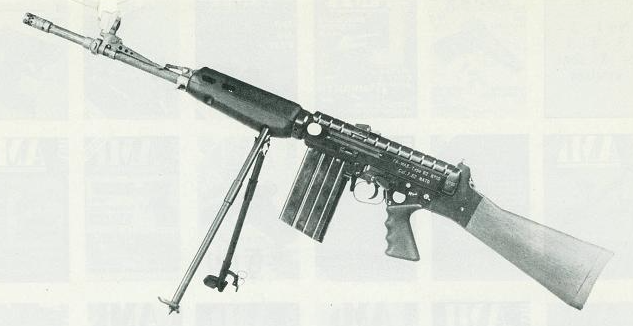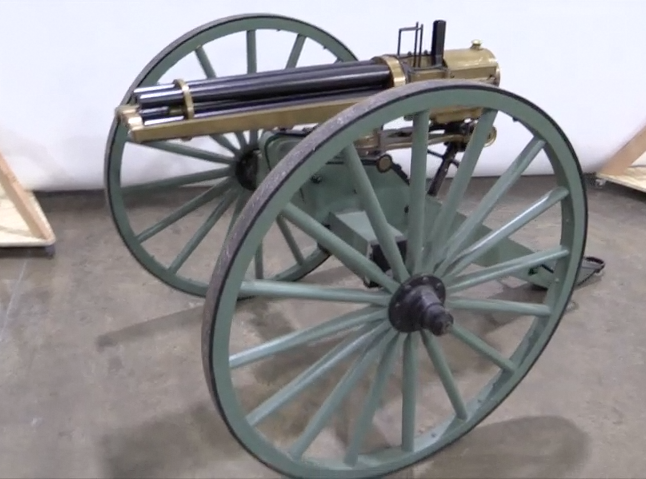Thanks to reader Thibaud, we have a translation of some of the testing results from the French military trial of the FN FAL and MAS Model 62. Thanks, Thibaud!

The documents tell us that the FA MAS 62 was tested along with the FN FAL, which was considered a benchmark. Here is the result of the testings :
- Sights: The sighting equipment of the FAL was prefered by French soldiers during testing because of its similarity to the ones of the FSA 49-56, more familiar to French soldiers.
- Sight adjustment: Satisfactory on both weapons. Some FAL rear sights were not enough tight to stay in place when shooting full auto.
- Trigger and fire selector: Trigger was satisfactory on both weapons. All testers prefered the fire selector on the FAL.
- Accuracy: Accuracy of the FAL was superior. Odd vertical dispersion with the 62.
- Handling during firing: Satisfactory with both weapons. Handling of the FAL was considered better. The adjustable stock on the 62 was apppreciated.
- Handling during scoped shooting: Satisfactory with both weapons. The adaptor to mount the scope on the 62, which is not needed to mount a scope on the FAL, was considered too fragile and complex. Possibility to use iron sights even when the scope was mounted on the 62 was appreciated over the FAL, which cannot be shot through the iron sights when a scope is in place.
- Handling and transport: Both weapons were considered light, easy to handle and not cumbersome. The FAL was prefered for its lighter weight (about 400 grams / 0.9 pounds less).
- Toughness and functioning: Satisfactory on both weapons.
- Notes during testing: advantage to the FAL for its ease to disassemble and clean. The 62 was considered overly complicated, with numerous parts, some of which were easy to lose.
4 units (of testing soldiers) out of 5 prefered the FAL for its “technical maturity, its practical solutions and its better results during shooting tests”. The FA MAS 62 was nevertheless the better when firing grenades, even if its mechanical construction is less robust.
The test results did not end in adoption of any rifle, the FA MAS 62 returning to the manufacturer and the FAL not adopted either. Some French unit were isued FN FAL in small numbers, as it seems there was a “FAL lobby” in the French army of that time. When the Defense Minister of that time, Michel Debré, was told this, he said in anger that “the weapon of the French soldier will be a French weapon!” (why does that not surprise me?). The FAL rifles in the French army were disposed of and never came back.




This was excellent material on a rifle I had never heard of. You have mastered the obscure and to me, the last of the interesting rifles. I’m researching obscure Finnish weapons. Do you know anything about the AR-10 Dutch made rifles that were chambered for 7.62X39 mm and sent to Finland? These would be the first of the Mutant AR/ AK hybrids. But the real white whale is uncovering documentation on a WW2 era Finnish semi auto rifle. I saw a picture of it in an old copy of Small Arms of the World, but I have never seen it referenced anywhere else.
“WW2 era Finnish semi auto rifle”
If you are searching info about Finnish WW2-era fire-arms check jaegerplatoon site, for experimental self-loading rifles: http://www.jaegerplatoon.net/ALMOST1.htm
Link to pics of the AR10 AI in 7,62X39 M43
* http://i616.photobucket.com/albums/tt247/OlGunner/leger-1.jpg
* http://oi59.tinypic.com/snyqu9.jpg
Link to the Rheinmetall 7.62X39 M43 base on CETEM/HK G3
* http://i1036.photobucket.com/albums/a443/hansellhd/Early_HK_762X39_C_zps1390cf79.jpg
* http://i1036.photobucket.com/albums/a443/hansellhd/Early_HK_762X39_A_zps9b72f37d.jpg
‘The FA MAS 62 was nevertheless the better when firing grenades…’
Am I right in assuming that the object on the barrel behind the front sight is a flip-up grenade launching sight?
The French really liked rifle launched grenades, post WWII.
Rifle grenades gave a serious boost to a squad’s firepower without eliminating a rifleman, affording the grenadier the lethality of a light mortar within its range, as well as some anti-armor, illumination, and smoke capability.
They still do:
https://elmundoenfotos.files.wordpress.com/2010/10/antitanque.jpg
http://koulouba.com/wp-content/uploads/2013/12/soldats-force-serval-position-combat-kidal-nord-mali.jpg
One of the most important requisite for the next assault rifle for the french army (by the way it will be 100% foreign made) is the hability to fire a LOT of rifles grenades without been burned-out after some shoots.
Yes, it’s the same sight used on the MAS 49/56, from all indications. It’s actually the “rear” sight, the “front” sight being the upper outer curve of the grenade body itself.
Not all that accurate, but as they say, with grenades, close counts.
cheers
eon
When evaluating any weapon intended for combat, never forget that it is a TOOL and the more reliable and foolproof the better. In combat there is no time to “tinker” with the weapon or try to find a part dropped in waist-high underbrush of knee-deep mud much less in the dark. This is why all Marines are required to show themselves able to field-strip and then re-assemble their weapons while blindfolded in less than a minute. Your and your team-mates’ lives often depend on it. So this must be at the top of the list unless the evaluator is serving behind a desk somewhere. It is also why even the Commandant MUST re-qualify with their TO weapon just like any other combat Marine. Ever seen a three-star suit taking orders from a Warrant Officer or a S/Sgt on the rifle range?
Also less parts mean than it is easier (faster, cheaper) to manufacture, unless this parts has very fancy shape; having 2 (or more) a bit worse weapons is better than having one
Finished boot/MCT last year. We never did it blindfolded. Did a lot of disassembly/reassembly and screaming ditties though.
When the Defense Minister of that time, Michel Debré, was told this, he said in anger that “the weapon of the French soldier will be a French weapon!”
I am glad that Britain did not have this policy, we would have been denied the Lewis gun, the Bren, the Maxim, the Thompson and the FAL, amongst others. We did go for a British design with the SA80, and that was a pig. However, even the French softened their position, because did they not buy SIG 540s to use before the FAMAS was ready?
In fact Manurhin SG540 was use in Lebanon by French army
* http://image-parcours.linternaute.com/image/750/3/2091802383/2754057.jpg
The only 3 manufacturers of the SG540 were Manurhin (in france), INDEP (Portugale) and FAMAE (Chilie)
About FAMAE and Manurhin, I have no doubts but are you sure regarding INDEP? I thought they were bound by their links to H&K.
I think there is a certain misconception regarding French nationalism and weapons procurement in that there really are probably just as many, if not more, realistic, open-minded, clear-thinking Frenchman as there are stubborn, overtly nationalistic ones. The tone of the evaluation report described above, along with the opinions of the troops involved, shows a lot of hard-headed objectivity and no tendency towards a bias in favor of the MAS 62. The real problem probably arises when the process gets up to a higher and more politically-driven level, as witness the obviously jingoistic remarks by Defence Minister Michel Debre ( who was, of course, a political appointee ).
This sort of accentuated “not-made-here” syndrome is hardly confined to France, as the historical record of firearms and weapons systems acquisition has consistently shown.
Hardly indeed. Hence why, for example, the US ended up with the lackluster M-14 in lieu of another .30 caliber rifle of the time.
The same pattern has always been apparent, and is by no means restricted to the French: more practical and objective lower echelons, with the degree of political and bureaucratic idiocy increasing as one ascends toward the rarified air of the upper levels of “leadership”.
Quite so, Steve, although I will say that the M-14 has nevertheless turned out to be a very capable weapon in its own right, even allowing for available and clearly better alternatives.
As for the increased degree of political and bureaucratic idiocy in the rarified atmosphere of the upper echelons of leadership, perhaps a case of anoxia ( oxygen starvation resulting in seriously impaired judgement ) commensurate with that sort of lofty altitude ( and attitude ) is something to be considered :).
“lackluster M-14″
But this weapons at least worked properly. Always remember than choice of worse weapons which at least work properly is better than adoption flawed weapons. Get for example US Navy Mark 18 WW2-era torpedo. USS Tang submarine (SS-306) fired Mark 18 torpedo which hit herself. WW2-era US Navy 1.1” AA gun
http://www.navweaps.com/Weapons/WNUS_1-1-75_mk1.htm
ammunition has flawed fuse design (too sensitive) so shell can explode before reaching target; these gun were replaced with 40mm Bofors guns as fast as possible.
“upper echelons of leadership”
The worst case is when dictator claims himself a “weapon expert” and will give orders. For example Tiger tank (Leningrad, 1942) and Panther tanks (Kursk bulge, 1943) were used before being matured due to Hitler’s order.
The US Navy has always had an…. ummmmm…. interesting torpedo history. When I was in boats in the late 70s we carried a mix of the old Mk 14s, the electric Mk 37, and the otto-fueled Mk 48s. There was always a great deal of concern about the possibility of the 37s spontaneously lighting off or “hot running” in the reload (probably why we always carried 48s, which even in the pre-ADCAP version was a great weapon, in the tubes). There was much (false, usually attributed to a Soviet attack) rumor among the crew about what had happened to the USS Scorpion, which sank in the late 60s. Turned out years later with the publication of “Blind Man’s Bluff” that the Scorp had a 37 hot-run and detonate in the reload – the Navy knew this and allowed/ encouraged the rumors rather than admit a very flawed weapon was still being carried in the fleet.
And who can forget the Mk 45 – a nuclear weapon with a delivery range of about 20 miles – the ultimate suicide vest!
Sorry for the typographical error, my friends, in Line 2 — this should read as “Frenchmen” and not “Frenchman”.
When the Defense Minister of that time, Michel Debré, was told this, he said in anger that “the weapon of the French soldier will be a French weapon!” (why does that not surprise me?).
Channeling Louis Quatorze, his first minister Colbert, and the spirit of (destined always to fail) mercantilist economics in general.
I suppose a few shots later will result in the statement “gone with his pants.” The issue with the French weapons development community was usually bureaucrats and old-school commanders messing with the private sector just because some of the less-talented companies happened to have better connections with the government and wallets so fat you could not sit on them!
Like most cases, the best French weapons were usually sidelined because of obstructive bureaucrats and the lack of money or will (or both) to continue with a good development path. Or am I wrong?
The French were extremely protectionists during De Gaulle’s presidency years in military matters, and it was a country that was mass-producing it’s own infantry weapons since Louis XIV’s (17th century) years, so…but it was of little importance if the MAS-62 or the FAL were good weapons as the vast majority of the military expenditures of the 60s went to the nuclear programs (bombs, warheads, ICBMs, submarines), the Air Force and the Navy… the French Army was last in many priorities lists…that’s why at the end they have to use the MAS-49/56 until the early 80s with some units equiped with locally made SG540.
If the French did use the FA MAS 62, it wouldnt be much different than the MAS-49 other than the 20 round magazine and full auto capability.
You can see some elements of the Mas49 in the design I think…
In his American Handgunner interview Stephen Hunter (the thinking gun nut’s novelist!) mused that the origins of some handguns somehow resonate with a national character – the Colt Peacemaker is obviously American, the Luger is unquestionably German, and the Webley is as British as fish and chips. To which I thought “Yup, the 8mm 1892 is pretty French, isn’t it?” Apparently, this applies to long guns as well – that thing just looks French!
Right , at this time MAT49 and MAS49/56 work well , FAL are good rifle but we do not has the prupose of it
MAs49/56 are a good battle rifle , everybody are agree whith that
j’ai utilisé ,un MAS 56 modifié 62 (dans le cadre d’un peloton “tireur d’élite” de janvier à mars 62 au 2ieme HUSSARD à Orléans ). particularité : une tige ,avec un point radio-actif (protégé par un sachet spécial ) pour les tirs de nuit .la crosse était posée sur le ceinturon et le tir se faisait au moment ou les projecteurs des chars s’éteignaient …….
je n’ai jamais retrouvé ” mon” fusil dans les divers documents d’internet.
pouvez-vous m’aider dans cette recherche ? merci d’avance .
cordialement.